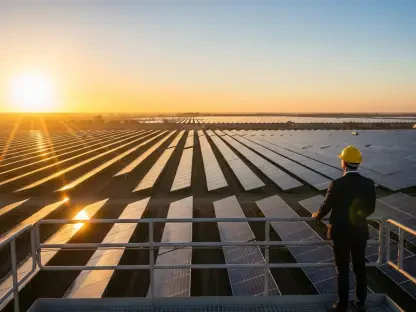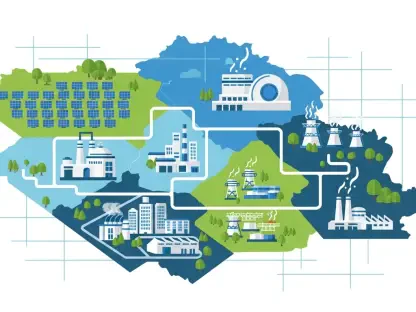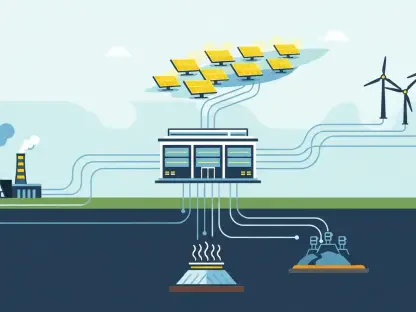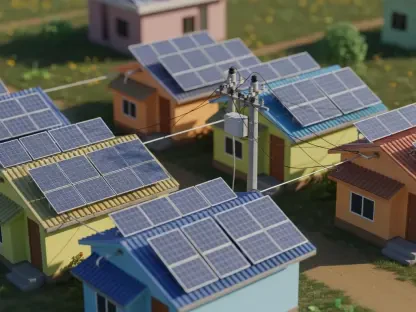In the era of artificial intelligence, where computational needs are experiencing unprecedented growth, data centers have emerged as indispensable infrastructures. With the burgeoning power demands of AI applications, the utility sector is undergoing a significant reevaluation to adapt strategies that meet these modern requirements effectively. This analysis delves into how the intersection of technology and energy supply is being reshaped, facilitating scalable and reliable power solutions for data centers.
Evolution of Data Centers: Historical Context and Developments
The past decade witnessed a tripling of data center activity, driven by enhancements in energy efficiency such as superior resource management, innovative cooling methods, and automation technologies. These improvements played a pivotal role in curbing otherwise escalating energy demands. Yet, the explosive growth in AI applications has fundamentally redefined these strategies, raising computational and power requirements to unprecedented levels.
As projections of a 160% surge in data center power demand by 2030 indicate, the need for electricity has more than doubled for the sector. The challenge lies in meeting these compounding demands, as AI workloads necessitate higher computational capabilities, dramatically amplifying electrical consumption. Early strategies prioritizing proximity to fiber optic networks are increasingly overshadowed by the crucial need for reliable power infrastructure.
Shifts in Power Availability and Developer Expectations
Redefining Priorities: Power as the New Frontline
The transition from fiber connectivity to power availability as the primary concern for data centers marks a profound shift in site selection criteria. Industry surveys highlight that now more than 84% of developers prioritize consistent power supply over network connectivity or geographical factors. These changes underline the critical advantage of rapid AI infrastructure deployment, particularly in competitive markets where power shortages can significantly hinder operations.
Aligning Timelines: Bridging Developer and Utility Expectations
A notable misalignment prevails between data center expectations and utility power delivery timelines, often lagging by one to two years. Utilities are innovating through decentralized solutions like fuel cells to mitigate this gap. By embracing these onsite energy solutions, utilities such as American Electric Power have succeeded in synchronizing with data center requirements, thus ensuring smoother power delivery timelines and complementing their broader infrastructure upgrades.
Regional Innovations and the Rise of Onsite Power Solutions
Addressing Regional Variabilities and Advances
Regional disparities in environmental standards demand unique energy solutions, compelling some areas to innovate with cleaner technologies such as solid oxide fuel cells (SOFCs). These innovations substantially reduce emissions and conserve water—key factors in regions with stringent environmental compliance requirements. This showcases a growing trend in harnessing advanced power technologies tailored to regional regulatory landscapes.
Growing Adoption of Onsite Generation
There is a growing interest in onsite power generation solutions, evidenced by projections that by 2030, 38% of data centers will rely heavily on self-supplied power, soaring to nearly 50% within a decade. This shift indicates a significant transformation, with companies increasingly adopting onsite systems for a reliable and scalable power framework. Equinix, for example, uses Bloom Energy’s fuel cell systems, significantly boosting self-generated power capacity across its data centers.
Future Trajectories: The Path to Larger Data Centers
The trajectory of mega-scale data centers is marked by an upward shift in power requirements primarily to support AI chips. Where a 30 MW facility was once typical, current demands have escalated to necessitate about 200 MW, with expectations pointing toward mid-century figures of 350 MW or more. This expansion leads to unprecedented pressure on energy infrastructure, compelling advancements in grid capacity and onsite generation solutions.
Strategies for Sustainable Power and Infrastructure
Survey findings underline the role of reliability, cost, and sustainability in shaping power architecture decisions. Fuel cells are emerging as a conducive choice, strategically balancing these factors with high efficiency and lower emissions. While involving considerable initial investments, their operational benefits offset long-term costs, positioning them as formidable players in sustainable power innovation.
Reflections and Strategic Recommendations
In light of the intricate challenges identified, there exists a clarion call for proactive stakeholder measures. By emphasizing strategic partnerships between utilities and data center operators, industry participants are set to navigate power delivery expectations more effectively. Investments in fuel cell technologies offer a promising avenue to meet sustainability goals while maintaining high operational standards. This approach aligns with emerging pressures of achieving reliability, cost-effectiveness, and compliance, underscoring the sector’s forward momentum toward a resilient power future.









